A quick note about twisted pairs: the technique was invented by Mr. Telephone himself, Alexander Graham Bell, back in the late 19th century. Telephone cables originally had just straight conductors, but as electrical power distribution became common, interference from power lines became a common issue with the transfer of telephone signals. Bell found that he could greatly reduce the electromagnetic interference (EMI) that was created by nearby electrical lines simply by twisting the telephone conductor wires. That same breakthrough approach is still used today in Ethernet cables as an anti-interference measure; all of the types of cables we’ve mentioned use twisted pairs of conductors.
However, it’s not always enough. Some environments are prone to greater-than-normal amounts of EMI, so there are cables designed to provide even more protection against interference. The protection is called shielding, and it brings us back to “U,” “F” and “S.”
Unshielded Ethernet Cables
UTP - Unshielded Twisted Pair
Normal twisted-pair Ethernet cables will usually perform just fine without extra shielding when used in home and small office networks that don’t have lots of equipment that will cause EMI. Since it’s unshielded (“U”), it’s referred to as “unshielded twisted pair” cable (or UTP for short). It’s much less expensive to manufacture cables without extra internal shielding, so UTP is the least-expensive Ethernet cable you can buy.
With no stiff shielding material inside, UTP is the thinnest and most flexible Ethernet cable on the market, making it the easiest to work with and install. It also has the extra advantage of not requiring a ground connection; more on that shortly. The majority of Ethernet patch cables or bulk cables that you’ll see sold are UTP.
Unshielded Ethernet Cables
U/UTP - Unshielded Twisted Pair
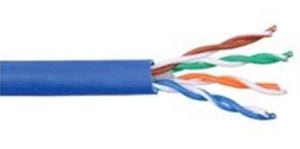
Also known as UTP, this is currently the most common and basic method of cable construction, consisting of pairs of wires twisted together. There is no shielding, instead the symmetrical twist in the wires create a balanced transmission line, helping to reduce electrical noise and EMI. In addition, the different twist rates of each pair can be used to reduce crosstalk. In higher category cables, a cross-web filler may be found separating the individual pairs to help reduce alien crosstalk from adjacent cables.
F/UTP - Foiled with Unshielded Twisted Pair
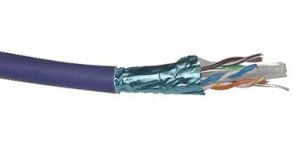
Often referred to as FTP, this type of cable features an overall foil shield wrapped around unshielded twisted pairs and a drain wire. When the drain wire is correctly connected, unwanted noise is redirected to ground, offering extra protection against EMI/RFI.
S/UTP - Shielded with Unshielded Twisted Pair

This cable construction has an overall braid screen with unshielded twisted pairs. This cable is often referred to as an STP, however this term should be used with caution due to other shielded cables also using this term. Always check whether the cable will have any shielding and whether individual pairs have their own shield. The cable is capable of supporting higher transmission rates across longer distances than U/UTP and provides better mechanical strength and grounding due to the braid.
SF/UTP - Shielded with Unshielded Twisted Pair
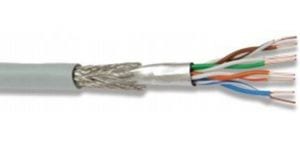
This cable has both an overall braid shield and foil shield with unshielded twisted pairs. This cable offers effective protection from EMI both from the cable and into the cable as well as much better grounding due to the additional braid.
Shielded Ethernet Cables
We now consider FTP and STP, which are each shielded Ethernet cables. The terms can be a bit confusing because they’re often used interchangeably, and each has extra components inside the cable in order to protect signals from interference. However, there is a difference between them.
STP - Shielded Twisted Pair
Independent shielded twisted-pair STP, each pair of lines has a foil shield, four pairs of wire together, there is a common metal braided shield, which is the standard structure of the seven categories of line . It is suitable for high-speed network applications, providing highly secure transmission, to support future new applications, help to harmonize the application of current network routing platform that enables e-mail to multimedia video from a variety of information, can be in the same set of high-speed system transmission.
FTP - Foiled Twisted Pair
FTP cable specifically uses a foil (“F”) shield wrapped around the outside of the twisted pair package, and does not protect the pairs individually. STP cable normally covers each of the twisted pairs separately with either foil or tightly-braided wire, with another layer of foil or braided shielding covering the entire conductor package.
U/FTP - Unshielded with Foiled Twisted Pair

This type of cable has no overall shielding but the individual twisted pairs are wrapped in a foil screen, offering some protection from EMI and crosstalk from adjacent pairs and other cables.
F/FTP - Foiled with Foiled Twisted Pair
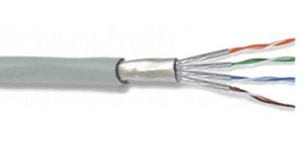
This type of cable features an overall foil shield with individually foil tape shielded twisted pairs. These are similar to F/UTP cables, with the addition of a foil shield around each twisted pair. The cable construction is designed to provide the assembly with greater protection from crosstalk from adjacent pairs and other cables, RFI and EMI.
S/FTP - Shielded with Foiled Twisted Pair

Similar to F/FTP, the individual twisted pairs are wrapped in a foil tape before being wrapped in an overall flexible yet mechanically strong braid screen. The additional foil on the twisted pairs helps to reduce crosstalk from adjacent pairs and other cables. The braid provides better grounding.
SF/FTP - Shielded with Foiled Twisted Pair
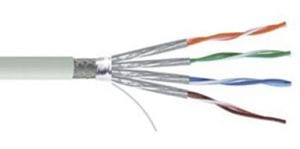
Offering the maximum protection from RFI/EMI, crosstalk and alien crosstalk, this cable has both an overall braid shield and foil shield, with individually foil tape screened twisted pairs. This type of cable provides the best level of protection from interference and better grounding due to the braid.
Conclusion
It’s more difficult to work with STP and FTP Ethernet cable because the extra shielding makes it thicker and stiffer, and because the need to keep the shielding intact makes the cable more fragile. Both types of cable also require a ground connection, since that’s where the interference snagged by the shielding is shunted. Shielded cables are best installed and maintained by professionals; of course, those are the people most likely to use them since UTP is sufficient for almost all home and casual applications.
Finally, a little extra information for the sake of completeness. If you’re confronted with a choice between straight-through or crossover cables, you’ll almost always want the straight-through cable. Crossover cables have some of the conductor wires reversed at the connectors but are only used these days to connect to very old computers or network switches.

